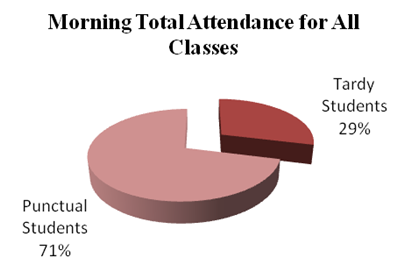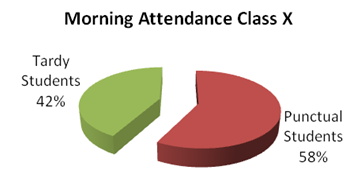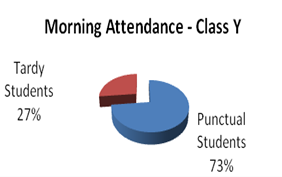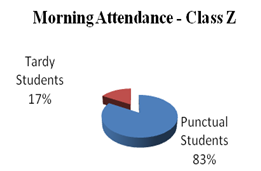Findings and discussion
The purpose of this study was to establish the effect of using alarm clocks on classroom attendance by schoolchildren. Themes emerging from the literature review indicate that tardiness is an endemic problem that has evolved throughout the history of education and that is duly reflected on post learning activities by those affected.
Nonetheless, it was also determined that some of the tardy students had extenuating concerns that militated against their desire to be punctual. Consequently, the researcher then constructed an experiment to discern whether the use of alarm clocks could alleviate the problem and improve on punctuality.
The methodology applied in the research study was action classroom research as outlined in the previous chapter. The research designed was to answer the following questions:
- Will the alarm clocks initiative have any effect on classroom attendance?
- Will seeking the parents’ assistance in the purchase of the alarm clocks happen as expected?
The methodology incorporated a blend of both quantitative and qualitative research methods whereby the collected data from the research was analytically reviewed by means of a thematic analysis. The quantitative data was gathered from the duty rooster and time sheet designed by the researcher to record the arrival times for all the respondents from the participating 3rd Grade classrooms.
The survey data was subsequently then entered into a Microsoft Excel spreadsheet for analysis of the statistical propensities during the two months survey period (See Table 1). The arrival timelines were also gauged against the average school attendance that was recorded by the school administration for the entire school comprising 28,400 students.
The total population of the participating 3rd grade students during the two months research period was 52. Although punctuality was gauged for the morning arrivals, the students were also monitored on class performance during the test period.
Tardiness seemed directly related to their grades in class. During the morning session, 15 students arrived late at least once during the trial periods thus representing a 29% rate on tardiness in the early morning school attendance (Figure 1). The 3rd Graders however improved in tardiness rising above the entire school average of 60%.
Figure 1

Among the three classes, class X had the lowest attendance record with eight students from a class of 19 arriving late. This resulted in 42% tardiness (Figure 2).
Figure 2

The other classes were better with class Y registering only 27% latecomers and class Z only 17% (Figure 3 & 4).
Figure 3

Figure 4

A grading scale was constructed that weighed the severity of the nonattendance or punctuality for the observed participating students. The grading scale was awarded on a typical 10-point grading scheme.
In this rating, a grading of 100% to 90% is an A, awarded to those late by just one day or less (none); 89% to 79% awarded a B for those late for three days or less.
A grading of 79% to 70% was awarded a C for those who were found late for five days or less; 69% to 60% graded D for those found late for eight days or less; and finally 59% and below graded F for those late for more than eight days (Table: 2).
Table 2
On the above grading scale, the entire 3rd Graders class scored B, a marked improvement in tardiness, being above the total school average of 60%, a D grade. Class X being the tardiest with only 58% punctuality rate was rated at F, while class Y was rated C for having 73% students punctual and class Z with 83% rated the best amongst the 3rd graders.
Interviews
Results from interviews with parents and teachers revealed the necessity of having alarm clocks to prompt tardy students. Most parents openly admitted that they were not very punctual themselves and attributed it to their upbringing on time in school.
Both parents and teachers admitted that this had adverse effects on learning as grades for the tardy students constantly registered poorer than those punctual do. The effect of post education proclivity to tardiness was noted constantly having devastating effects. Dismissals for those at work likely among other disorders in life.
Summary
There was a marked improvement on punctuality during the trial period attributed to the presence and the use of alarm clocks as the total school average was over 60%. Interviews with the respondents noted keenness by the participants to use the alarm clocks as facilitators for punctuality to school and class. Students’ behavior patterns also improved with morning attendance improving tremendously particularly for class Z.
The study thus sought to answer the following research study questions:
Will the alarm clock initiative have any effect on classroom attendance?
It was established that the alarm clock initiative had some evident effect on the students’ attendance. This was manifest due to the improved attendance registered as measured against the entire school students’ attendance rate, which averaged at 60 percent while there was also a positive impact on class attendances during the trial period.
Thus, the introduction of the alarm clocks motivated the students to be more punctual though the improvement could have been better in some classes.
Will seeking the parents’ assistance in the purchase of the alarm clocks happen as expected?
There were no reported cases of parents refusing to purchase the alarm clocks though some were not prompt enough and had to be constantly reminded before the onset of the study. The researcher in anticipation of reimbursement by parents lent those lacking the clocks.
Although the research had sought to purchase standardized clocks to reduce incidences of malfunction, most parent claimed to have the gadgets in their possession hence were not ready to purchase new ones. Thus, it can be concluded that the issue of alarm clocks was sufficiently covered and the ensuring results for the study proved evidence of the use and impact.
The study has therefore answered our research questions with the introduction of alarm clocks having a great impact on class attendance. Similarly, the parents affably and enthusiastically support the project as evidenced with no reported instances of non-cooperation from them.
However, on the issue of purchasing the clocks, some parents were of the opinion that they already owned the gadgets. Ultimately, the study was quite successful and proved the need to have prompters in form of alarm clocks to improve on tardiness while actively engaging parents paid dividends.
Limitations of Study
Like other studies, several limitations were noted during the course of the research study. The first limitation was that the researcher had limited control over the basic instrument for the study; the alarm clock, which had to be operated by the students within their homestead, could not be monitored.
The researcher’s second limitation was in ensuring the cooperation of parents. Parents could minimized the necessity for the initiative and not taken it seriously. Another limitation was the inadequate time for the study. The assessment period of two months was not enough to gauge the class performance in relation to their grades.
Finally, a fourth limitation was noted in ensuring the cooperation of the teachers, in class X, the poor results indicated some lack of proper supervision by the class teacher, which eventually affected negatively on their performance
Bias
The nature of the teacher/student relationship was judged to induce some sort of bias since the students were likely to cooperate during the study period to avoid being victimized by their teachers as opposed to the study being conducted by an outsider.
The lack of an independent supervisor could also induce some bias since the researcher was responsible for the whole exercise. The influence of teachers to prompt students was a possible bias.
Validity
Validity was carefully instilled during the study period with various measures undertaken constantly. These included triangulation, peer review with fellow teachers and professionals, and careful review of the interview questions and the results of the study by the researcher conducted to verify the validity.
Golafshani (2003) affirms that reliability and validity can be established if the construed outcomes are reliable or related even if the quantification or analysis is redone. However, reliability is statistically non-irrefutable but can only be estimated hence surmising the accuracy of the analysis.
Implication for the Research Study
The immediate observation from the study was the impact of the alarm clocks on the observed students with a marked improvement on punctuality and general attitude change towards learning. The study indicates that tardiness may not be entirely due to student sluggishness but could be due to domestic factors militating against punctuality.
The involvement of the parents also leads to a more positive contributory attitude from them as they become more involved and responsible. Thus, this study has confirmed the effectiveness of action research in solving endemic problems as active learning generates positive results in preparing students academically and in their duties after school.
The study is thus vital for improving in eradicating tardiness amongst schoolchildren as this impacts on their learning and later life. Educational officials and school authorities can therefore conduct further studies to reduce the high incidence of tardy students.
Nonetheless, the study poses some further questions on whether an independent study by non-teaching staff can produce the same results. A more comprehensive research study that will necessitate a longer observation period is recommended, particularly if collaborated by a careful examination of class performance.
This new study should also seek a follow up on former students who were either tardy or exceptionally punctual to appraise their after-school performance.
Thus, a linkage can be made on tardiness, class grades and after school performance. If the students can voluntarily employ alarm clocks and finally and most important, whether parents are ultimately responsible for the development of tardiness in their children or is it a genetically hereditary factor?
Reference
Golafshani, N. (2003). Understanding Reliability and Validity in Qualitative Research. Toronto: University of Toronto.


